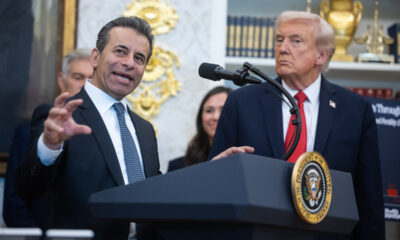Politics
Trump Demolishes East Wing in Controversial $300 Million Project

President Donald Trump has initiated the demolition of the East Wing of the White House, a move that has sparked significant controversy and raised questions about oversight and accountability in his administration. The project, which is estimated to cost $300 million, aims to create a new ballroom, but critics argue it reflects a troubling disregard for the historical significance of the building and the needs of American citizens.
The East Wing was reduced to rubble as part of Trump’s plan to construct what he has termed the “Donald J. Trump Ballroom.” Critics point out that this lavish expenditure comes at a time when approximately 20 million Americans face potential loss of health care benefits due to cuts to social programs. The juxtaposition of a grandiose ballroom and the plight of vulnerable populations has led many to question the priorities of the Trump administration.
In a recent fundraising effort, Trump solicited contributions from wealthy donors, promising recognition in association with the new ballroom. Among the donors were executives from major corporations such as Google, Amazon, Lockheed Martin, and Microsoft. This has raised concerns about the influence of corporate interests on government decisions and the potential for conflicts of interest.
Trump previously assured the public that the East Wing would remain untouched during the renovations. In a statement reported by The New York Times, he claimed, “It won’t interfere with the current building. It’ll be near it but not touching it.” However, with the East Wing now demolished, this promise has been broken, further eroding public trust.
The scale of the project has alarmed various preservation groups. The National Trust for Historic Preservation formally requested a pause on the demolition to allow for a legally mandated public review process. Their request was ignored, reflecting a broader trend of dismissing institutional oversight under Trump’s administration.
Additionally, the National Capital Planning Commission, which is responsible for assessing external construction projects in Washington, D.C., found itself sidelined. Trump has indicated he would submit plans to the commission at a later date, despite the fact that demolition has already begun. This lack of adherence to established protocols has raised eyebrows among experts and advocates of historical preservation.
The implications of Trump’s actions extend beyond the demolition of a single building. Critics assert that he is undermining the rule of law and the checks and balances that have been in place for over two centuries. The absence of significant opposition from Republican leaders in Congress has further emboldened his approach to governance, with many feeling that the constitutional safeguards designed to limit executive power are being systematically dismantled.
In light of these developments, the question remains: who will hold the administration accountable? Public protests have erupted, with citizens demanding “No Kings” and calling for a restoration of democratic principles. Yet, the response from those in power has been muted, leaving many to wonder if there are any “adults in the room” willing to challenge Trump’s unilateral decisions.
The demolition of the East Wing serves as a potent symbol of the broader issues facing American democracy today. Without meaningful oversight or constraints on executive power, the consequences could extend far beyond a single construction project, affecting the very fabric of governance and civil rights in the United States.
-

 Health7 days ago
Health7 days agoRare Brain Condition Discovered More Common in New Mexico
-

 Politics1 week ago
Politics1 week agoPrince Andrew Steps Back from Royal Duties Following Epstein Memoir
-

 Entertainment1 week ago
Entertainment1 week agoTrump Commutes George Santos’ Sentence, Sparks Controversy
-

 Sports1 week ago
Sports1 week agoMLS Decision Day 2025: Playoff Spots on the Line as Teams Clash
-

 World1 week ago
World1 week agoYoung Driver Dies in Collision with Box Truck in El Cajon
-

 Politics1 week ago
Politics1 week agoNavy Veteran Max Quattromani Launches Campaign for Assessor Seat
-

 Lifestyle1 week ago
Lifestyle1 week agoKent Hamilton Named Southeastern Farmer of the Year at Expo
-

 Sports1 week ago
Sports1 week agoSaquon Barkley Reacts to James Franklin’s Dismissal from Penn State
-

 Health1 week ago
Health1 week agoRemembering Mary Ingleby: A Life of Love, Teaching, and Music
-

 Science1 week ago
Science1 week agoIdaho State University Launches Haunted Science Laboratory on Oct. 25
-

 World1 week ago
World1 week agoNevada Treasury Awards 2025 Kenny C. Guinn Memorial Scholarships
-

 Health1 week ago
Health1 week agoFDA Introduces First Nine Recipients of National Priority Vouchers









